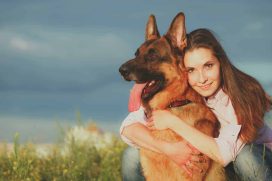Labradoodles can eat a wide variety of foods, but not all of what we feed them is actually good for them. Some foods are just unhealthy and not good for your dog, whilst other foods can make them seriously ill.
So what can a Labradoodle eat and not eat?
Let’s take a look at some foods that no dog should eat, some foods that a good for almost all dogs, and some foods that can be extra healthful for your Labradoodle.
Foods that you should NEVER give To your Labradoodle
Labradoodles are really no different to other dogs when it comes to the food you cannot give them. Some foods are poisonous, some are bad for their health and some are just dangerous and can cause choking. Here’s a list of foods you should never give to your labradoodle.
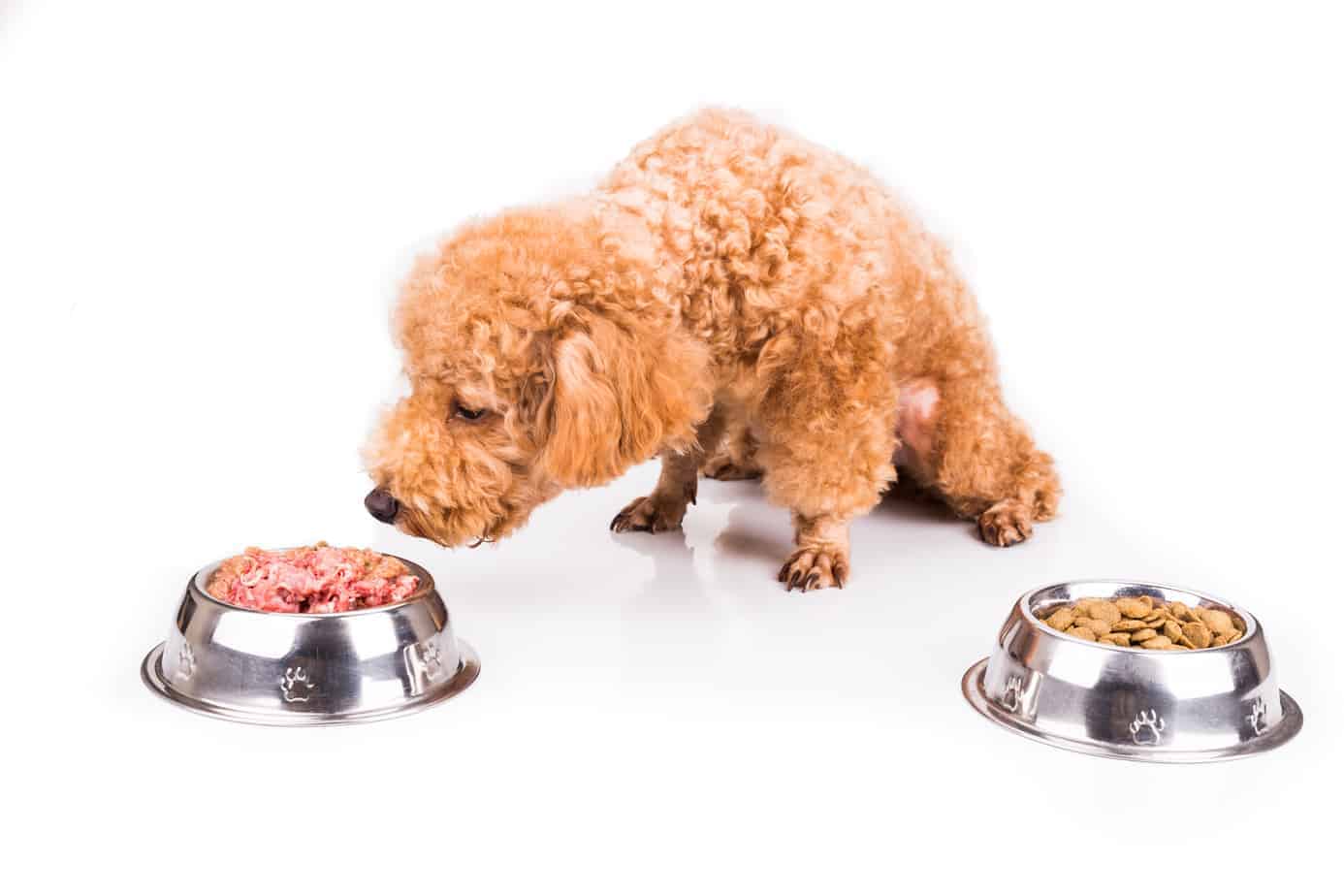
1. Cooked Bones
Raw bones are fine to give your Labradoodle, but once they are cooked they become dangerous! Cooking a bone makes it brittle. This can cause the bones to splinter when the dog eats it. These splinters can poke holes in the dog’s digestive tract. You don’t have to throw cooked bones away though! You can still use them to make bone broth.
2. Coffee, Tea, and Caffeine in General
These products are dangerous because of their caffeine. The stimulation effects of caffeine can be enough to cause irregular heartbeat, vomiting, diarrhea, seizures, and death in Labradoodles and dogs in general. Note that this is not just the liquid products of brewed coffee and tea.
Dogs should also be kept safe from the coffee bean, coffee grounds, tea leaves, and brewed products. It’s worth saying here that ALL caffeine is not good for dogs. This includes energy drinks, caffeinated sodas, and anything containing caffeine. 110-120mg of caffeine per kg of dog is toxic to them. As a reference point, an 8oz cup of coffee has about 91mg of caffeine.
3. Alcohol
We all know that alcohol isn’t even good for humans, especially in excess. The same effects that alcohol has on people happen to dogs, except it is amplified because your dog is a lot smaller than you.
Alcohol can cause vomiting, inhibited motor function, nervous system depression, liver damage, coma, and death. Never give your Labradoodle alcohol, and be sure to keep them safe from it if it is anywhere around.
4. Grapes, Raisins, Wine
Grapes, grape juice, dried grapes (raisins), wine, and anything else containing grapes can be very toxic to Labradoodles.
Consumption of grapes can cause sudden kidney failure in dogs. 0.3oz of grapes or 0.05oz of raisins per pound of body weight has been seen to cause kidney failure in dogs. If a 60-pound dog were to eat 2oz of raisins this would cause kidney failure.
5. Foods containing Xylitol
Xylitol is a sweetener alternative. It has zero carbs and has become quite popular in zero carb gums, sodas, candies, toothpaste, and other products. It is a naturally occurring sweetener. Xylitol has no known bad effect on humans but it can wreak havoc on your Labradoodle.
Normally, when sugar or carbs are eaten that triggers insulin to be released to get some of that sugar out of the bloodstream. This lowers the blood sugar. However, when a dog eats zero carb xylitol their body still releases insulin. This causes the blood sugar to go too low. Xylitol can cause vomiting, loss of coordination, fatigue, seizures, and liver failure. If a dog consumes 50mg of xylitol per pound of their body weight that is enough to cause damage to your dog.
6. High-Salt Foods
Salt is a natural and normal part of the body and it is needed for normal body function. However, too much salt can cause problems. Vomiting, diarrhea, seizures, tremors, even kidney damage, and death can occur if too much salt is ingested.
It’s best to keep your dog away from table salt, soy sauce, and playdough. Also, be sure to provide plenty of freshwater for your dog if you visit the ocean. If your dog drinks too much ocean water they can develop salt poising. Just 4g of salt per kg of dog is lethal, and less than that can cause plenty of damage too.
7. Yeast Dough
Feeding your Labradoodle yeast dough is very dangerous. The dough will continue to expand as it travels through the dog’s digestive tract. At best, it will cause discomfort, gas, and bloating. At worst it can cause a dog’s stomach to twist or his intestine to rupture.
These last two things can be life-threatening. Yeast also creates alcohol as it expands, as discussed above alcohol can cause its own set of issues. Be sure that your dog doesn’t get a hold of any yeast dough or yeast.
8. Macadamia Nuts
If a Labradoodle eats macadamia nuts they will experience weakness, vomiting, tremors, and hyperthermia. Macadamia nuts can affect the nervous system. As little as 2.2g per kg of body weight can affect dogs negatively. Dogs intolerance to the toxin in macadamia nuts can vary quite a lot, however, it is best to just avoid letting your dog get any.
9. Pits
Most fruit pits contain toxins that a Labradoodle should not eat. Pits include those from cherries, persimmon, peaches, plums, apricots, and avocados. Apple seeds should also be avoided.
10. Human Vitamins, Supplements, and Medications
Most vitamins, supplements, and medications made for humans are made in doses for a an adult sized huamn. If your 65 pound Labradoodle gets a hold of some of your medication it could be very bad for them.
That said some human supplements may be helpful for your pet depending on any health issues. You can use human grade supplements for some things. Just be sure to take into account your dog’s weight and the fact that human doses are for a 150lb human. It’s best to get advise from your vet before giving your Labradoodle any supplements.
11. Raw Salmon, Raw Wild Boar
These two items contain potentially fatal parasites when fed raw. For salmon, it is best to cook it or make sure you buy it from a seller that knows how best to freeze it to kill the parasites. A better option is give your Labradoodle some salmon oil with his dinner instead.
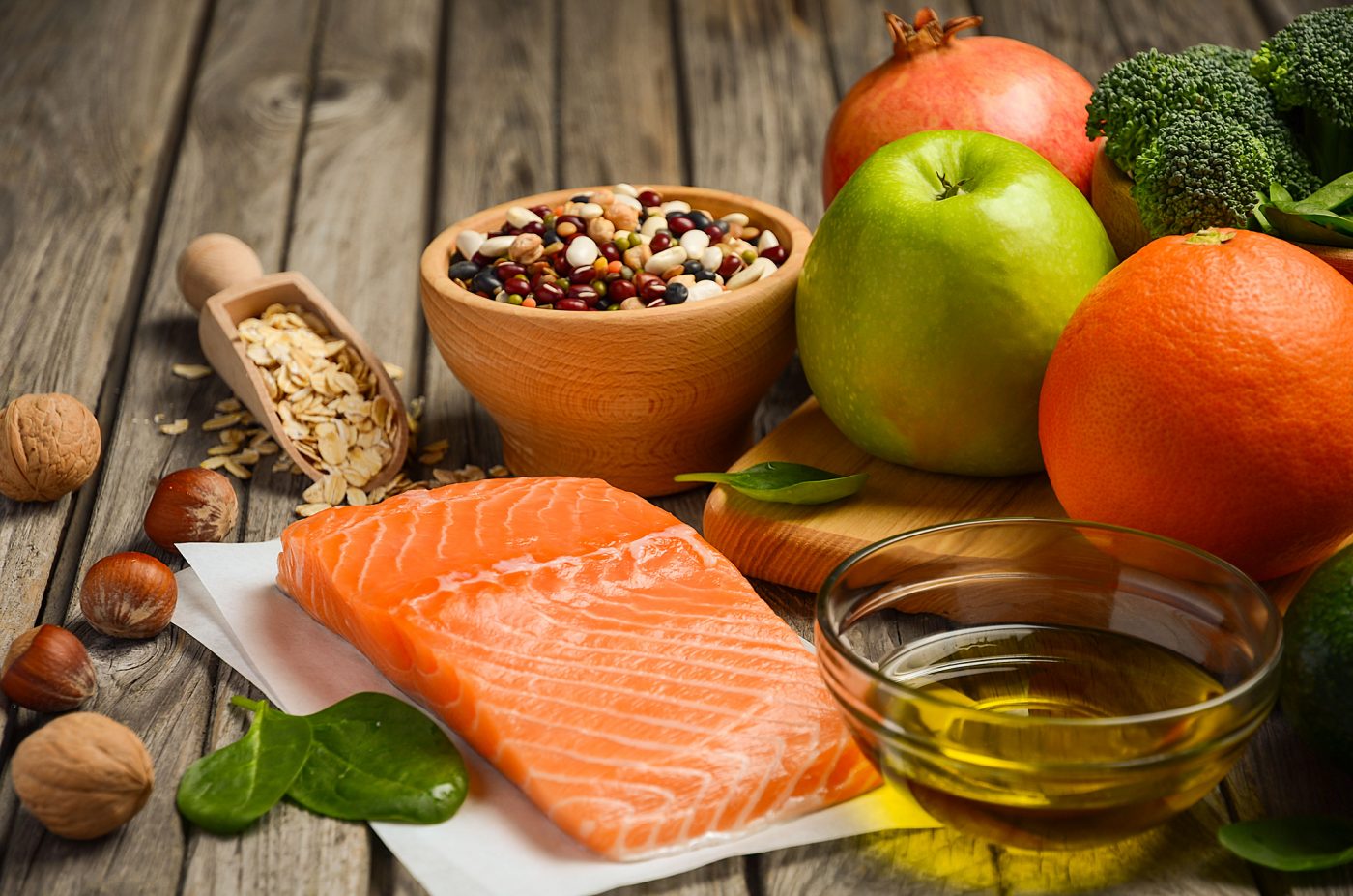
12. Peanut Butter That is not 100% pure
Peanut butter often contains added sugar which is not good for your dog or worse some contain xylitol. Peanut butter is also very high in omega-6 fatty acids which are not great for most dogs. Peanuts also contain aflatoxins which can cause cancer.
13. Sugar and Other High Carb Foods
You shouldn’t feed your Labradoodle high sugar foods such as ice-cream or candy such as marshmallows. High amounts of sugar and carbs are not good for your Labradoodle. They can cause a whole host of health problems including obesity, heart disease, dementia, joint pain, inflammation, dental disease, diabetes, the list goes on.
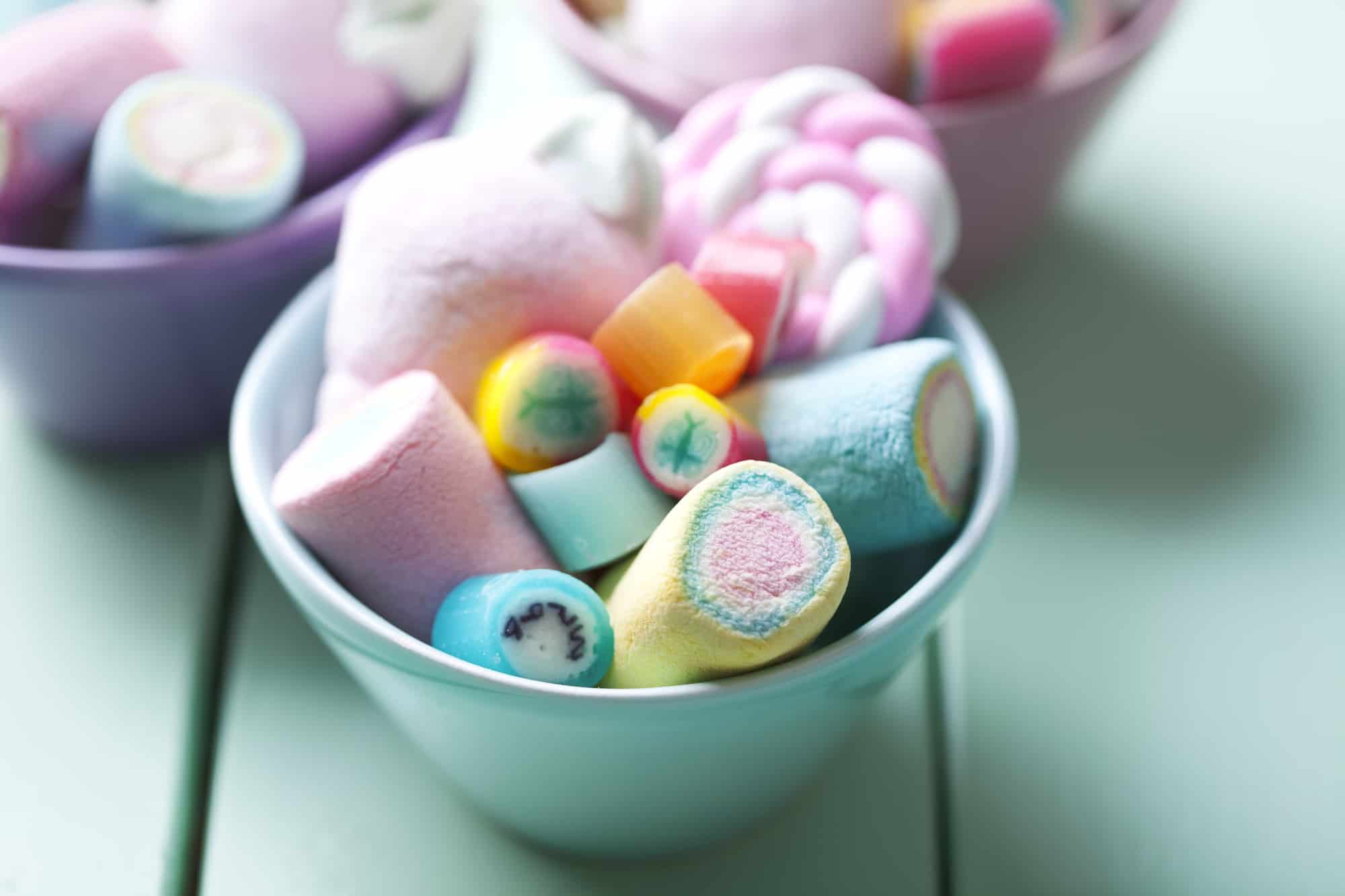
Candy such as marshmallows are not good for Labradoodles (or any dog)
While a small number of carbs can be okay for a dog, large amounts are just not necessary. Indeed dogs have no dietary need for carbs, only fat and protein. It is also worth noting that most cancer cells use only carbs and sugar as a fuel source. If your dog has cancer then cutting out carbs could potentially heal him.
14. Chocolate
I love good chocolate, but I never share chocolate with my dog. Chocolate contains a compound called theobromine that can be quite toxic to dogs. Baking cocoa, unsweetened dark chocolate, and dark chocolate have the highest concentrations of theobromine making them more dangerous than milk or white chocolate.
1oz of milk chocolate per pound of bodyweight will do significant harm especially to senior dogs or dogs with heart issues. When it comes to chocolate just don’t. While a tiny crumb might be okay, you don’t want your dog to develop a taste for it.
What Are The Foods That Your Labradoodle Can Eat?
So what can you safely feed your labradoodle? Personally I feed my dogs a raw meat diet, with some steamed vegetables and raw vegetables as treats.
Labradoodles need a balanced food source and this can be obtained from a raw meat diet or a grain free, good quality dry food.
1. Meat
No surprise here! Dogs are carnivores and thrive on a diet of meat, raw bone, and animal fat. They can eat meat raw, cooked, freeze-dried, and dehydrated. For most dogs, a diet that consists mostly of raw meat and bone is best! Remember don’t feed your dog raw salmon or wild boar. Free-range, grass-fed, pasture-raised, and organic meats are best.
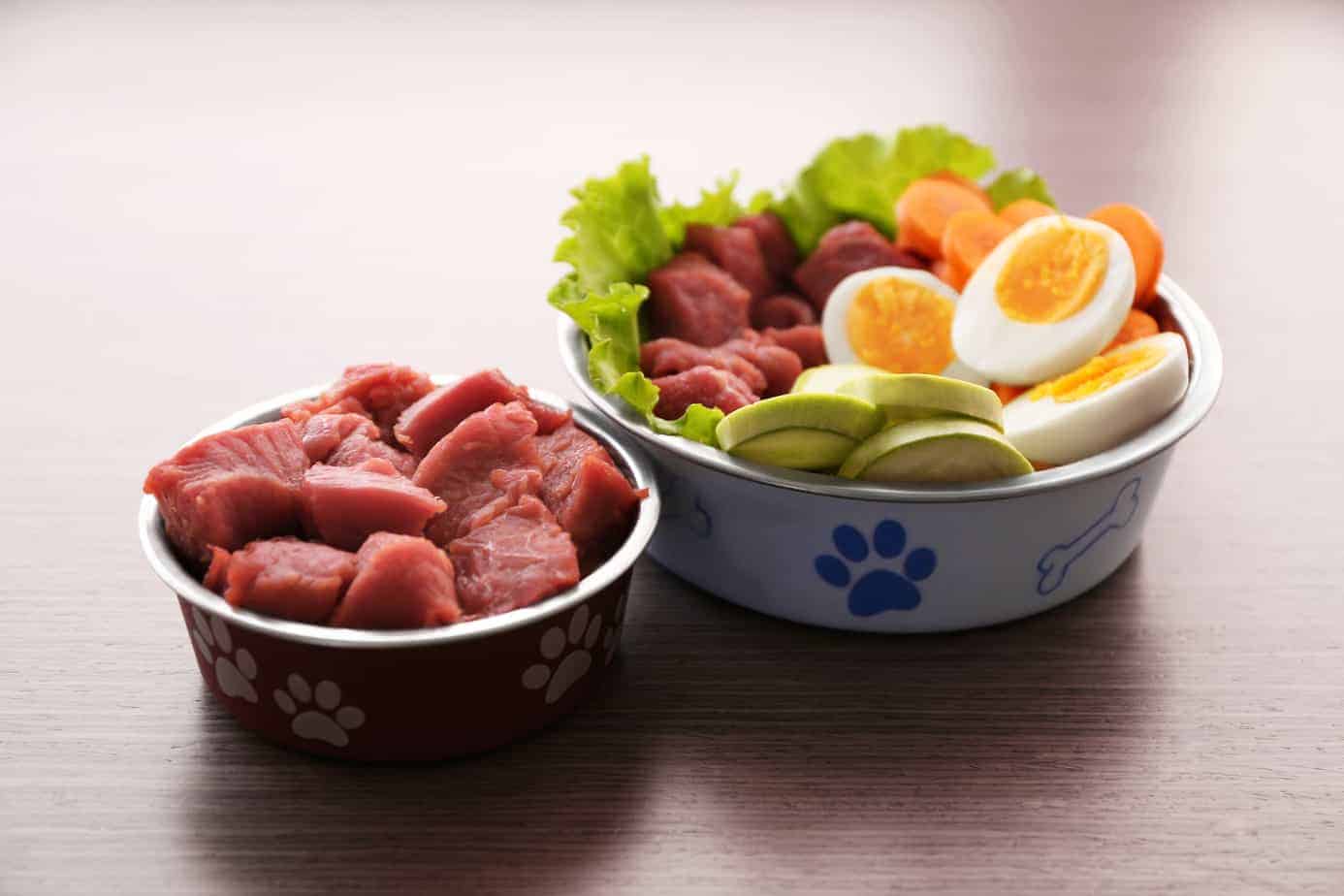
An example of a raw meal for a dog
2. Small Fish
Small fish such as sardines, mackerel, and anchovies can be a great source of omega-3 fatty acids. If properly sourced and handled you can even feed sardines raw. Larger fish are more likely to contain contaminants and heavy metals, it’s best not to feed your beloved pet these fish. Wild-caught is best.
3. Organ Meat
While organ meat seems pretty gross and gooey, it’s a great addition to your dog’s diet. Think of organ meats as a perfect, natural multi-vitamin for your Labradoodle. Organ meats are best from ethically raised animals that are fed a species-appropriate diet and get plenty of sunshine.
Feed organs raw for maximum benefit. It’s great to feed as many organs as you can get your hands on the liver, heart, lungs, pancreas, eyes, brain, kidneys, tripe, spleen, tongue, even glands. In traditional Chinese medicine, they believe that “like-cures-like.” So, if your dog has a heart issue feeding heart can help to heal your dog’s heart.
4. Raw Bones
There are two kinds of raw bone that you should be aware of. Recreational bones are for your dog’s enjoyment, a treat to chew on. This is great for your dog’s dental and mental health. A dog getting to chew on a recreational bone is like a person getting to sit down and read a great book. Relaxing and stimulating at the same time.
The other type of bone is the kind that your dog can consume, a raw meaty bone. These bones are great for dental health as well as providing your dog with calcium and phosphorus. Recreational bones are generally weight-bearing bones, think femur bones, knuckle bones, pelvic bones. Raw meaty bones are going to be things like the neck, some ribs, and even duck and chicken feet. Free-range, grass-fed, pasture-raised, and organic bones are best.
5. Skin, Fur, Feathers
If your Labradoodle suffers from a skin allergy or other skin issue feeding your dog skin can be of great help. While skin is fairly high in fat, this is not an issue for most dogs when fed in moderation.
Also, feeding fur and feathers can be a useful source of fiber for your Labradoodle as well as providing other nutrients. Again, seek high-quality skin, fur, and a feather from ethically raised animals that get plenty of sunshine and are fed a species-appropriate diet.
6. Eggs
Eggs can be fed raw or cooked to your Labradoodle. They will have the most nutrients when fed raw. Eggs are considered to be one of the most complete foods in the world. With the most complete amino acid profile we know of. You can even feed your dog the whole egg, shell and all! It’s best to get organic, pasture-raised eggs.
7. Greens and Vegetables
There are several greens and vegetables that are great to feed your Labradoodle. Just remember that some vegetables are high in carbs and it is best to limit or avoid these veggies. Greens are particularly healthful for dogs. In the wild, dogs will sometimes eat grasses, so feeding greens is sort of mimicking that.
Alfalfa and dandelion greens are particularly healthy. Dandelion greens are a great prebiotic fiber that will feed your dog’s gut bacteria, this is a good thing. Be sure to feed organic greens and vegetables. Dog’s don’t digest vegetables very well so it’s best if they are either lightly steamed or pureed.
8. Some Berries and Fruit
There are lots of berries and fruits that Labradoodles can eat and enjoy. Most fruits can be very high carb however so don’t feed too many of them. Fruits, and especially, berries are full of healthy antioxidants that can help your dog thrive.
9. Fermented Foods
This group included kimchi, kavass, kefir, yogurt, fermented broth, and water kefir. Sometimes you can even find fermented meat products. These food contain healthful probiotics that help to take care of the gut. A healthy gut means a healthy immune system. A healthy immune system means a healthy dog. You can feed a probiotic supplement as well if you desire. These are best-made form organic veggies or organic grass-fed dairy.
10. Bone Broth
Bone broth is full of healthy minerals, gelatin, glucosamine, and deliciousness. It can aide in appetite stimulation. Bone broth is great to feed a sick Labradoodle, giving him nutrients even if he doesn’t feel like eating. Think of it as chicken soup for dogs. Be sure to use pasture-raise, species-appropriate feed, bones.
11. Garlic and Herbs
Despite what you may have heard garlic can be very good for Labradoodle and dogs in general. The key is to use fresh, raw, organic garlic (not the pre-minced variety). You’ll have to chop it yourself but this will provide the most health benefits to your dogs. Garlic is anti-parasitic, anti-fungal, anti-biotic, anti-tumor, and anti-cancer, to name a few benefits.
There are lots of other herbs that can prove helpful to your dog as well. Herbs can be a great form of medicine. Most pharmaceutical drugs are based on herbs and food items. Parsley, for instance, can be a great detoxifying herb. Basil can help with tick-borne illnesses and arthritis. Turmeric is a great anti-inflammatory herb.
12. Fat
Fat is probably the second most important nutrient for dogs after protein and should definitely be part of your Labradoodles’ diet. It is certainly more important than carbs in a dog’s diet. Moderation is key. Most people agree that too much fat can cause or aggravate pancreatitis. However, some promote a ketogenic diet for dogs, this is a high-fat diet. Many dogs especially those with cancer and certain health issues have found relief and healing on this diet.
Fat can also be an excellent, sustained energy source for canine athletes. So, if you plan on doing agility, dock diving, swimming or some other canine sport with your Labradoodle consider adding in more fat to his diet. Be sure to choose organic animal fats. Beef tallow, coconut oil, duck fat, skin, well-marbled meats these are all great sources of fats for dogs. Let’s not forget those fatty fish too!
What foods help with health problems in Labradoodles?
1. Joint Dysplasia
Be sure you go to see your breeder before you get a Labradoodle to make sure that the puppies are not raised on a slick floor. Slick floors can cause early joint damage and dysplasia issues.
Also, be careful not to spay or neuter your dog before sexual maturity. Doing so could result is joint damage among other issues.
Turmeric, ginger, CBD oil, bone broth, raw trachea, chicken feet, oxtail or pigtails, and green-lipped muscles are all great foods to add to help prevent joint issues.
2. Heart Issues
For heart issues prevention, be sure to feed omega-3 fatty acids. This can be in the form of a supplement like krill oil or feeding fatty fish like sardines. CoQ10 is a great addition to the diet. You can find natural CoQ10 in high amounts in heart, so feeding raw heart is a great option. Remember “like-cures-like.” Provide plenty of exercise for your Labradoodle.
3. Eye Health
Orange foods such as carrots and pumpkin can help support eye health in Labradoodles. Omega-3 fatty acids are helpful for eye health as well. Also, feeding antioxidant-rich foods like, blueberries, dandelion, and alfalfa can be of great benefit.
4. Bloat
Feeding a raw diet can help to prevent bloat. The high-carb content of kibble makes it more likely to cause issues for your carnivore. Feeding your dog raw meaty bones will strengthen your dog’s digestive tract and the muscles need to digest. This will help to prevent bloat. Do not feed your dog from a raised bowl this has been directly linked to bloat. Be sure to exercise your dog, but never right after a meal.
5. Epilepsy
Interestingly before there were anti-seizure medications the only treatment for epilepsy was a ketogenic diet. So, if you focus on feeding little-no carbs and plenty for meat and healthy fat this should help to prevent epilepsy. CBD oil can also prove very helpful.
When Should You Feed your labradoodle and how much food?
If feeding a raw diet a Labradoodle should be fed 1-3% of their body weight daily. This varies depending on the activity level and age of your Labradoodle. When feeding a commercial diet follow the manufacturer’s instructions and adjust as needed to maintain a healthy weight.
Depending on your lifestyle, feeding one, two, or even three times a day may be best for you. I don’t recommend “free feeding” where the dog has access to food all day. It’s much better to feed meals. This makes it easier to check in on your dog’s health. Did he eat his breakfast? If you know he didn’t eat, this could be an indication that he is ill.
That said you can also experiment with fasting your dog. Fasting your dog can have several benefits including boosting the immune system, helping the gut, and aiding the body in getting rid of dead cells. This isn’t to reduce calories, per se, so you still need to make sure your dog gets plenty of nutrients when he does eat.
Labradoodles may be prone to weight gain. But remember you control what goes in your dog’s bowl. Most Labradoodles could benefit from a fasting program. Also, remember that fillers in the food you feed, like those in kibble, are going to make your dog feel hungrier. This is because he is not getting the nutrients he needs, just a bunch of filler.
Sources
https://www.aspca.org/pet-care/animal-poison-control/people-foods-avoid-feeding-your-pets
https://www.nomnomnow.com/blog/dangerous-human-foods-for-dogs
https://www.ncbi.nlm.nih.gov/pmc/articles/PMC3550263/
https://www.webvets.com/Resources/resource.php?Grape-and-Raisin-Toxicity-by-Frank-Utchen-DVM-6





